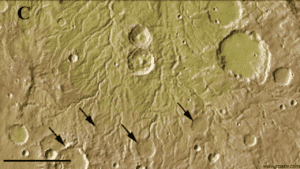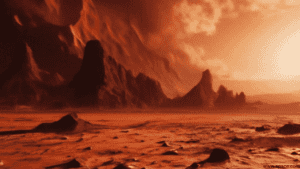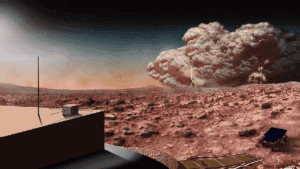Mars Rain – Could It Ever Rain on the Red Planet?
Mars, with its dainty air and outrageous cold, presents an unforgiving climate for climate peculiarities like downpour. In contrast to Earth, where water fume gathers and falls as fluid drops, Mars misses the mark on fundamental climatic circumstances for fluid precipitation. The planet’s environment is made basically out of carbon dioxide, with very little water fume. Subsequently, Mars rain is at present unimaginable because of deficient strain and the bone chilling temperatures that keep fluid water from shaping. Rather than downpour, the Martian surface every so often encounters ice and ice, especially at the posts, where temperatures are cold enough for carbon dioxide to freeze, making what researchers call “dry ice snowfall.”
While Mars rain is unimaginable today, downpour on Mars is a subject of interest among scientists checking future colonization out. Assuming that people were to terraform Mars — changing its air to become thicker and hotter — it’s possible that downpour could turn into a reality in the far off future. By falsely expanding how much water fume and making a nursery impact, researchers hypothesize that fluid water could ultimately shape, prompting Mars rain. Nonetheless, this is as yet a speculative idea, reliant upon huge progressions in innovation and a top to bottom comprehension of Mars’ perplexing natural elements.
Does Mars Have the Right Conditions for Rain?
The Composition of Mars’ Atmosphere
Mars’ climate is principally made out of carbon dioxide (95%), with minor parts like nitrogen, argon, and follow measures of water fume and oxygen. The slender and inadequate climate, with a strain under 1% of Earth’s, makes it almost unthinkable for fluid water to exist on the Martian surface for any lengthy period. The low water fume levels are especially critical, as they forestall the development of mists or climate frameworks like those on The planet.
On account of these variables, Mars rain is beyond the realm of possibilities under current circumstances, as the planet comes up short on dampness and barometrical tension expected for precipitation. All things considered, Mars encounters climate peculiarities like residue tempests and ice, with a periodic snowfall of carbon dioxide or “dry ice” close to the posts.
Regardless of these unforgiving circumstances, researchers have for some time been fascinated by the chance of Mars rain in the far off past. Land proof recommends that Mars once had a thicker climate and streaming waterways, which could have upheld downpour like precipitation billions of years prior. This period probably finished when Mars lost a lot of its climate to space, bringing about the cool, dry planet we see today. Understanding the piece of Mars’ air is vital to concentrating on its environment history and deciding if conditions might at any point be adequately adjusted to consider Mars rain later on, potentially through terraforming or other trend setting innovations.
Temperature Extremes on Mars
Mars encounters probably the most outrageous temperature changes in the nearby planet group, to a great extent because of its meager air and distance from the Sun. Daytime temperatures close to the equator can reach up to 20°C (68°F), however around evening time, they dive radically to as low as – 73°C (- 100°F). In certain districts, temperatures can decrease significantly further to – 125°C (- 195°F) during winter at the posts. These super cool temperatures keep fluid water from existing in the world’s surface, which thus implies Mars rain can’t happen. Water, if present, stays frozen or sublimates straightforwardly from ice to fume while never going through a fluid stage.
These temperature swings likewise influence the potential for any precipitation. Despite the fact that Mars has follow measures of water fume, the temperatures are excessively low to support mists equipped for delivering precipitation. Rather than Mars rain, the planet encounters ice and, at the shafts, carbon dioxide snowfall. In specific circumstances, water-ice mists can frame, however they just outcome in a light ice as opposed to rain.
For downpour to at any point fall on Mars, the air tension would have to increment fundamentally, alongside a radical climb in temperature. Researchers concentrating on the chance of terraforming Mars frequently investigate whether adjusting the planet’s temperature might one day at any point lead to Mars rain, making conditions more appropriate for supporting human existence.
Historical Evidence of Water on Mars
Mars, frequently alluded to as the “Red Planet,” holds critical land proof recommending that fluid water once streamed across its surface. Old waterway valleys, lake beds, and deltas found in satellite symbolism show that Mars had a lot wetter and hotter environment billions of years prior. These arrangements are leftovers of what researchers accept were tremendous seas and waterway frameworks. The presence of minerals like hematite and mud, which structure within the sight of water, further backings this hypothesis. During this time, the thicker air and higher temperatures could have permitted Mars rain to happen, adding to the disintegration and forming of the planet’s surface highlights.
Nonetheless, as Mars lost its air to space, the planet’s capacity to hold fluid water lessened. The drop in barometrical strain made any surface water dissipate or freeze, abandoning just hints of its watery past. Today, water on Mars exists for the most part as ice, found at the polar ice covers and underneath the surface. The chance of Mars rain is as of now not practical under current circumstances because of the planet’s flimsy air and outrageous virus
. In any case, concentrating on this verifiable proof of water is critical to understanding how Mars progressed from a wet climate to the dry, fruitless scene it is today. Yet again if future endeavors to terraform Mars succeed, reestablishing the planet’s barometrical strain and temperatures, Mars rain might actually return, changing the planet.

What Happens Instead of Rain on Mars?
Dust Storms on Mars
Mars is well known for its huge residue storms, some of which can inundate the whole planet for quite a long time or even a very long time at a time. These tempests are driven by the slender Martian climate, principally made out of carbon dioxide, and the planet’s low gravity, which permits dust particles to remain suspended for extensive stretches.
At the point when daylight warms the surface, it makes air rise, kicking up fine residue into the environment. When a residue storm begins, it can rapidly fill in size and power because of Mars’ dynamic weather conditions. While these residue storms are normal, they feature the planet’s dry and fruitless climate, where Mars rain is nonexistent, and dust assumes a predominant part in molding the climate.
In contrast to Earth, where downpour assists with settling residue and clean the environment, the shortfall of Mars rain implies that residue tempests can wait and lastingly affect the planet’s surface. Without the presence of fluid water to overload the residue, these tempests can obscure the sky for a really long time, decreasing daylight and influencing sun based fueled hardware on Mars.
Rather than Earth’s tempest frameworks, which include water fume and precipitation, Mars’ weather conditions is characterized by dust tempests and outrageous cold, without really any opportunity of downpour to lighten these circumstances. In the event that climatic changes at any point happen on Mars, empowering fluid water and the chance of Mars rain, the planet’s residue tempests could diminish in recurrence or power, prompting a more Earth-like climate framework.
Frost and Ice Precipitation
Mars is a planet characterized by chilly temperatures and a dainty climate, which makes remarkable climate peculiarities, especially including ice and ice. In contrast to Earth, where fluid water goes through precipitation, Mars encounters an altogether different sort of precipitation — one driven by the buildup of carbon dioxide and, in uncommon cases, water-ice particles. The planet’s typical temperature of around – 80°F (- 60°C) considers the development of ice in specific locales, particularly during the colder seasons and close to the posts. Despite the fact that Mars rain can’t happen because of the dainty air and absence of significant water fume, ice and ice precipitation act as the nearest thing to precipitation on the Red Planet.
In the Martian winter, carbon dioxide (CO2) freezes out of the air, making a layer of ice that covers the surface. This is especially observable at the polar ice covers, where frozen CO2, otherwise called “dry ice,” frames enormous occasional stores. Not at all like water ice on The planet, this dry ice sublimates straightforwardly once again into the climate when temperatures increase, avoiding the fluid stage through and through. This sort of ice isn’t like Mars rain; all things being equal, it is a novel component of Mars’ outrageous environment. The slender air, made generally out of CO2, works with this sort of precipitation, however forestalls water-based weather conditions that are normal on The planet.
Water-ice precipitation exists on Mars, yet it is significantly less normal than carbon dioxide ice. During explicit environmental circumstances, water fume in the air can consolidate into mists, shaping ice that is made of water ice. These mists are by and large meager and structure in the upper layers of the Martian air. Notwithstanding, rather than falling as Mars rain, this ice settles softly on a superficial level, generally liquefying or dissipating rapidly once presented to daylight. This cycle is profoundly confined and normally just occurs in freezing districts, further underlining the planet’s failure to support fluid water or the sort of precipitation Earth encounters.
The presence of ice and ice on Mars indicates the planet’s antiquated, wetter past. Billions of years prior, Mars probably had a thicker environment and hotter environment, which might have considered Mars rain or comparative types of precipitation. Proof of antiquated stream valleys and lake beds proposes that water once streamed on the Martian surface, conceivably recharged by precipitation. Today, be that as it may, Mars is a chilly, desert-like world, where ice and ice are the main types of precipitation.
Understanding these examples is urgent for future investigation, as the quest for water stays one of the vital variables in deciding Mars’ tenability and potential for supporting human existence. While ice and ice precipitation offer a brief look into Mars’ weather conditions, the fantasy of Mars rain stays far off, requiring huge changes in the planet’s barometrical circumstances to turn into a reality.
Atmospheric Snowfall
Mars encounters an extraordinary type of precipitation known as air snowfall, however it is very not the same as the snow we see on The planet. Rather than water-based snow, Mars encounters carbon dioxide (CO2) snowfall, frequently alluded to as “dry ice” snow. During the Martian winter, particularly close to the shafts, temperatures decrease so low that CO2 freezes straightforwardly from the environment, framing fine, frigid particles that tumble to the surface.
These snowfalls are commonly light and can cover the ground with a slight layer of CO2 ice. Not at all like Earth’s blizzards, the absence of dampness in the Martian environment forestalls water-based snow or Mars rain from happening, as the circumstances are excessively dry and cold for fluid water to exist.
While water-ice mists truly do sometimes shape in the upper layers of Mars’ air, they seldom produce snowfall and, in any event, when they do, it is very light and dissipates rapidly. The idea of Mars rain stays slippery because of the flimsy environment and very low temperatures, which keep water fume from gathering into fluid downpour or significant snow.
In any case, understanding the elements of CO2 snowfall and how it communicates with the planet’s surface is significant for future investigation, particularly while thinking about possible human colonization. Changing Mars’ barometrical circumstances to make Mars rain is a subject of progressing research, however for the time being, air snowfall stays perhaps of the most striking climate peculiarity on the Red Planet.
Terraforming Mars to Create Rainfall
Terraforming Mars is an idea that includes modifying the planet’s climate and surface circumstances to make it more Earth-like and fit for supporting human existence. One of the vital objectives of terraforming is thicken Mars’ climate, raising its temperature and barometrical strain to the point of supporting fluid water. With a denser climate and more water fume, researchers speculate that Mars rain could ultimately turn into a reality. By acquainting ozone harming substances with warm the planet or utilizing cutting edge innovation to set caught water free from the polar ice covers, we might actually establish an environment where water can burn through mists and fall as downpour, like Earth’s hydrological cycle.
Notwithstanding, the difficulties of making Mars rain are colossal. Mars’ environment is at present made primarily out of carbon dioxide, with very little water fume, and temperatures are unreasonably cold for fluid water to exist for extensive stretches. To terraform Mars, huge innovative advances would be required, including techniques to produce heat, discharge more water into the air, and shield the planet from sun based radiation.
In the event that effective, Mars rain would be a stupendous move toward making the planet tenable, giving a wellspring of new water for future settlements and empowering horticulture. While these thoughts are as yet speculative, continuous investigation into Mars’ environment and air carries us nearer to understanding what it would take to change the Red Planet into a spot where downpour might one day at any point fall.
What Rain on Mars Would Mean for Human Colonization
The potential for Mars rain holds critical ramifications for the eventual fate of human colonization on the Red Planet. Right now, Mars is an unforgiving climate with a meager air that can’t uphold fluid water, making endurance trying for any human pioneers. Notwithstanding, on the off chance that terraforming endeavors were fruitful and the climatic circumstances were changed to take into consideration Mars rain, it could establish a more cordial climate. Fluid water wouldn’t just be fundamental for human endurance however could likewise uphold agribusiness, empowering homesteaders to develop food as opposed to depending entirely on resupplies from Earth. The presence of downpour would mean a practical water cycle, possibly changing Mars into a more Earth-like biological system.
Besides, the event of Mars rain would upgrade the planet’s capacity to support complex living things and could encourage the improvement of a more strong biosphere. With reliable precipitation, surface water bodies like lakes and streams could shape, advancing biodiversity and making a decent environment. This change would be indispensable for making a self-supporting province where human existence can flourish without consistent reliance on outside assets.
The capacity to bridle nearby water sources through precipitation would altogether lessen the calculated difficulties of moving water from Earth. Eventually, the possibility of Mars rain could be a distinct advantage in our endeavors to colonize the planet, making ready for humankind’s development past Earth and the foundation of a super durable presence on Mars.

Conclusion: Is Mars Rain Possible?
Whether or not Mars rain is conceivable remaining parts a dazzling theme for researchers and space fans the same. Right now, the Martian climate presents critical difficulties for the presence of fluid water. With a dainty air made predominantly out of carbon dioxide and outrageous cold temperatures, the circumstances important for precipitation as we experience on Earth are a long way from being met. While Mars encounters ice and CO2 snowfall, these peculiarities don’t liken to fluid precipitation. The possibility of **Mars rain** relies on significant headways in how we might interpret the planet’s environment and the potential for terraforming endeavors that could adjust its climatic circumstances.
In any case, the fantasy of Mars rain isn’t completely too far. With progressing investigation into environment change and expected innovative forward leaps, researchers are investigating ways of making a thicker climate and raise surface temperatures. In the event that fruitful, these endeavors could make ready for fluid water to spin through the environment and hasten as downpour.
The ramifications of accomplishing Mars rain would be significant, changing the planet into a more neighborly climate for future colonization and empowering human existence to thrive. While we may not as yet have the responses, the quest for understanding Mars and its true capacity for downpour keeps on motivating investigation and development, carrying us nearer to the fantasy about making the Red Planet a second home for humankind.




